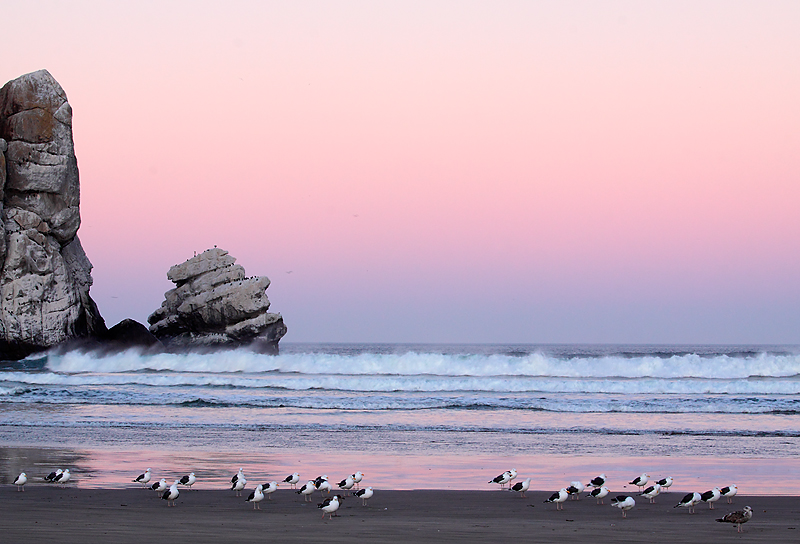
BIRDS AS BULLETIN #283
JAN 20, 2008
Visit www.BIRDSASART.com
Please give the images a minute or two to load and do make sure that your security settings are not preventing you from seeing them. (Some folks just need to click on “Show (or Allow) Images” on the frame of the e-mail. If you have any trouble at all viewing this Bulletin, you can access it in the Bulletin Archives here: http://www.birdsasart.com/bn283.htm
Inspirational, Educational, & Fun. Honest critiques done gently: www.BirdPhotographers.Net (It Ain’t Just Birds!)
THE LEPP INSTITUTE TRIP REPORT
COMING UP: THE LOS OSOS/MORRO BAY AREA SITE GUIDE
EQUIPMENT REVIEW: THE CANON 800MM F/5.6L IS LENS
NEOS KUDOS
IPT UPDATES
Contact us by phone at 863-692-0906 (Eastern Time Zone) or by e-mail at birdsasart@att.net or birdsasart@verizon.net. The att e-mail address is best from overseas.

Western Gulls and edge of Morro Rock at sunrise, Morro Bay, CA
Image copyright 2009
Arthur Morris/BIRDS AS ART
Tripod-mounted Canon 70-200mm f/4 L IS lens with the EOS-50D (on the Mongoose M3.5). ISO 400. Evaluative metering +1 stop: 1/15 sec. at f/16.
Pink light (above) at dawn and orange skies (below, at sunset) abounded. I went with the slow shutter speed to blur the waves a bit. Note also the careful framing of the gull flock.
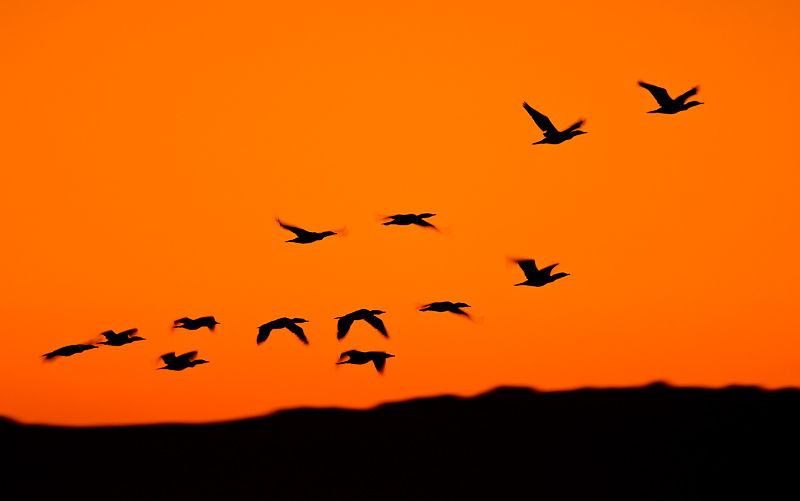
Cormorants headed for evening roost, Morro Bay, CA
Image copyright 2009
Arthur Morris/BIRDS AS ART
Handheld Canon 400mm f/4 DO IS lens with the EOS-1D Mark III. ISO 800. Evaluative metering +1 1/3 stops: 1/80 sec. at f/4.
With the 50D on the 800 I kept the 400 DO on a strap on my shoulder with the 1D MIII for situations that required a wider view. When photographing small and medium sized flocks in flight watch for a pleasing shape along with good spacing of the individual birds. When two or more birds merge with each other it is somewhat distracting.
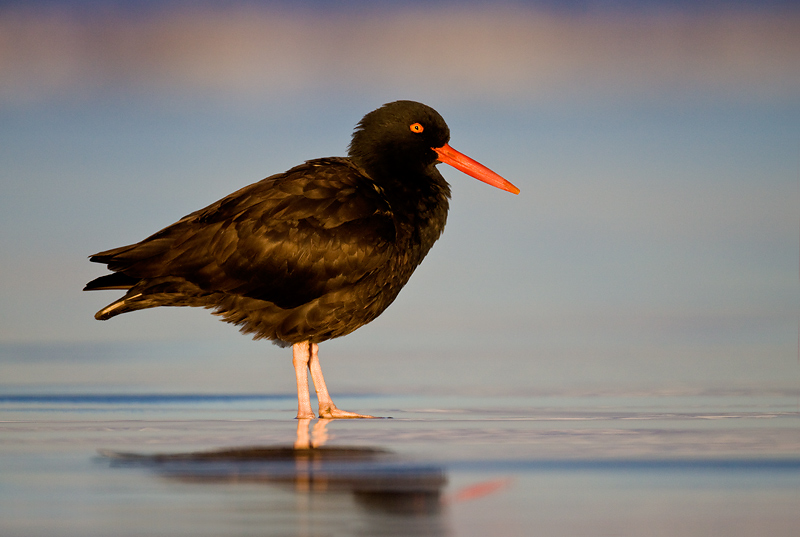
Black Oystercatcher, Morro Bay, CA
Image copyright 2009
Arthur Morris/BIRDS AS ART
Canon 800mm f/5.6L IS lens with the EOS-50D on the Gitzo 3530 LS CF tripod and a Mongoose M3.5. ISO 800. Evaluative metering +1/3 stop: 1/250 sec. at f/5.6.
I was photographing some gulls when I noticed that this bird had landed right in front of young photographer Aidan Briggs. I retracted the legs of my tripod, spread them, and got on the ground. With the great magnification offered by the 800/50D combination I was able to stay well back and avoid scaring the bird away while still filling the frame with the subject. In more than 35 years of birding on the west coast I had never seen this species land at the edge of the surf and neither had anyone else; they loves rocks and rocky shores. This wonderful experience was just one of my many wonderful blessings; it was simply a great trip.
THE LEPP INSTITUTE TRIP REPORT
On Friday, January 9th, I flew to San Luis Obispo, CA to conduct two programs at the Lepp Institute. I had been invited by Hal and Victoria Schmitt who purchased the Institute from George Lepp less than two years ado. At present, George is connected by name only to the school that he founded but still teaches a course at LIDI every now and then. Hal and Victoria ("Vicky" is reserved for her Mom) are both competent photographers and expert Photoshop instructors. Hal spent 14 years in the US Navy as a Top Gun fighter pilot; I greatly enjoyed hearing his stories. With the 15 computer work-stations at the school we spent a bit more time optimizing images than on a typical IPT but that worked out well as nary a cloud was seen during my entire visit. (As most of you know, I do not like photographing in the harsh light of a bright midday.) In spite of the economic downturn, the week-long class was a near sell-out with 8 of the 10 slots filled while the weekend course was sold out. Multiple IPT and Bear Boat veteran Bill Keown (along with his lovely wife/birder Chris) and newbie Jim Johnson, as nice a gent as you would ever care to meet, signed up for both courses. The rest of the Monday-Friday crew was rounded out by John Mullen, Bill Henderson, Linda Sewell, Kay Petterson, Jack Bonewell, and Joel Kocen. Joe Naudzunas (who was on a Gannets Galore IPT with Chris Dodds and I) and life-partner Kelly Parady joined Bill, Chris, and Jim for the weekend session.
Victoria and I began scouting the Los Osos/Morro Bay area late Friday afternoon and found a few good spots. As the week-long course progressed, we kept following our collective noses to the birds and the light and wound up with a great variety of early morning and late afternoon opportunities. The clear sunrises and sunsets yielded lovely pink/purple/blue skies in one direction and rich orange yellow skies in the other. Long-billed Curlew was the star of the show especially for this long time shorebird lover. A variety of gulls, ducks, grebes, loons, several other shorebird species and even a few passerines rounded out a pleasing cast of characters that included both ground-squirrels and otters. I for one was glad to get to make some good images of male and female Brewers Blackbirds and a male Anna's Hummingbird added spice to our last morning. And there was even some great scenic photography.
The mornings were cool, in the low to mid-forties most days and we turned on the rental car Aces on most afternoons. My incredible weather luck held up once again. I am famous for bringing good weather to San Diego when I visit so I guess that I can now add the Los Osos/Morro Bay area to the list. A great time was had by all and those in the week-long course who wished got to print their favorite images on Friday.
On the Sunday before the courses began I spent a great morning photographing the birds at Morro Bay from an Orchid Outrigger canoe. This was a wonderful experience as it was a still calm morning. High tides are best. Mike my guide skillfully positioned the canoe into perfect photographic position. You can learn more about Orchid Outfitters (owned by Mark Schulman who paddled and guided for Victoria that morning) here: http://orchidoutriggers.com/
On a final note you can learn more about Hal and Victoria and the Lepp Institute offerings here: www.leppphoto.com. They have an extensive course schedule in place. Upcoming guest instructors include Tim Grey, Jack Davis, Fay Sirkis, Helene Glassman, and Lewis Kemper. BTW, Hal—who only recently has become addicted to bird photography—operates a boutique winery in Paso Robles; if you enjoy a good bottle of wine, click here: www.volatuswine.com.
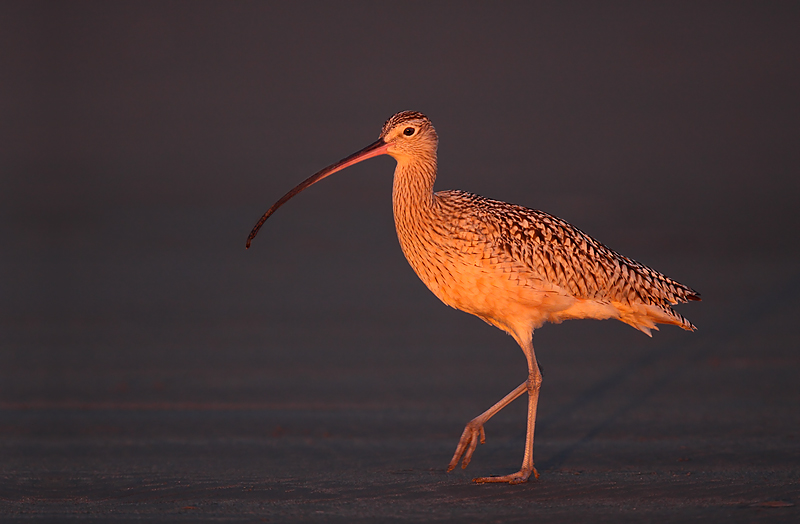
Long-billed Curlew on black sand, last rays of sun, Morro Bay, CA
Image copyright 2009
Arthur Morris/BIRDS AS ART
Handheld Canon 400mm f/4 DO IS lens with the EOS-50D. ISO 800. Evaluative metering at zero: 1/640 sec. at f/4.
The 50D/400 DO combo is deadly with nice reach (about 13X magnification) and superb AF. Metering is quite different from that with the MIII; you need to use much less light in a given situation to create a good histogram without having an flashing highlights. This species was surely the star of the show.
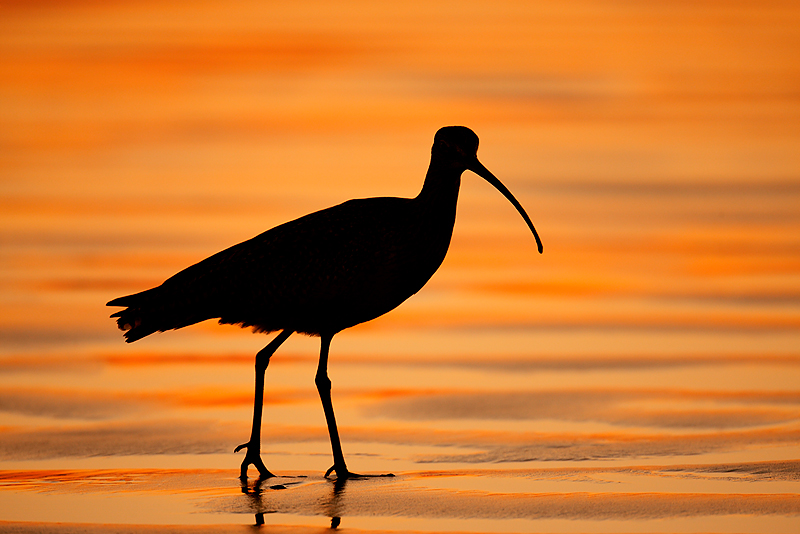
Long-billed Curlew at sunset, Morro Bay, CA
Image copyright 2009
Arthur Morris/BIRDS AS ART
Canon 800mm f/5.6L IS lens with the EOS-1D Mark III atop the Gitzo 3530 LS CF tripod and a Mongoose M3.5. ISO 400. Evaluative metering +1 2/3 stops: 1/200 sec. at f/5.6.
With the 800, I was able to create this image while more than 100 feet from my subject thus assuring zero disturbance. The 800 is razor sharp at the wide open aperture and contrary to some internet reports (as usual) I did not note any vignetting at f/5.6 (though there may be some with a full frame camera at f/4.)
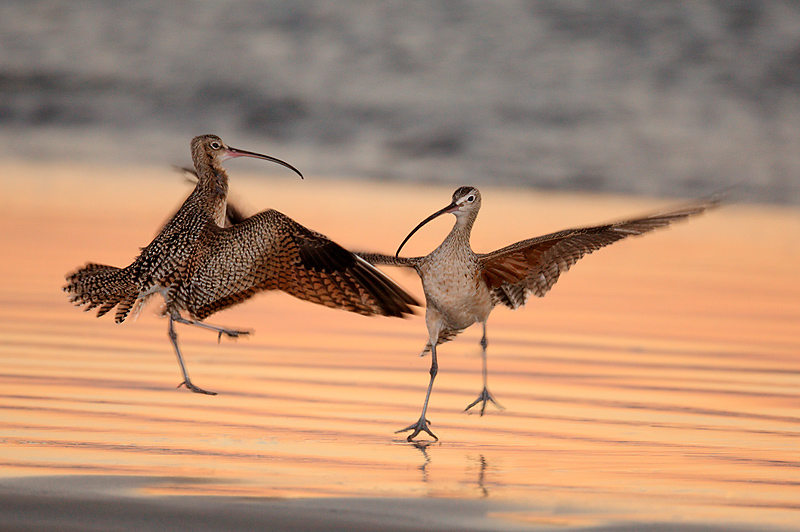
Long-billed Curlews squabbling at sunset, Morro Bay, CA
Image copyright 2009
Arthur Morris/BIRDS AS ART
Canon 800mm f/5.6L IS lens with the EOS-1D Mark III atop the Gitzo 3530 LS CF tripod and a Mongoose M3.5. ISO 800. Evaluative metering +2/3 stop: 1/250 sec. at f/5.6. Fill flash in Manual mode at 1:1 with the Better Beamer: http://www.birdsasart.com/accs.html#BEAMER)
As I was more than 130 feet from my subjects, I knew that even full power with the flash would act only as fill. In the low, low light I remember praying for the lens to focus, and it did! This species is constantly fighting over prey items (usually sand crabs).
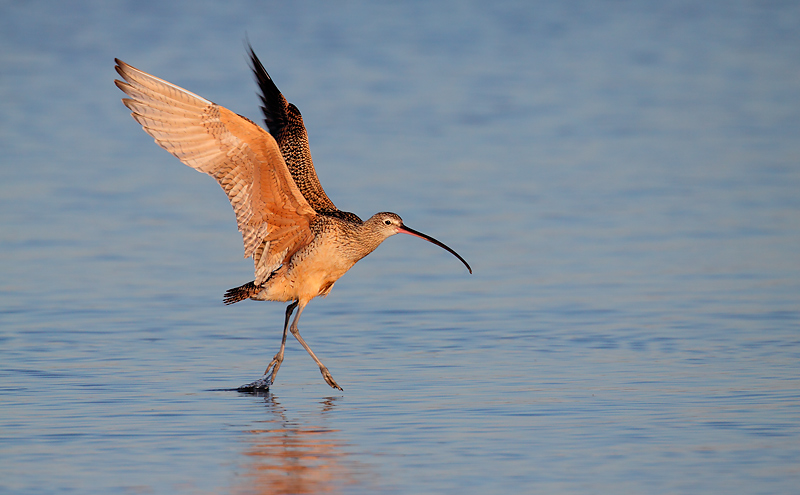
Long-billed Curlew landing, “walking on water,” Morro Bay, CA
Image copyright 2009
Arthur Morris/BIRDS AS ART
Canon 800mm f/5.6L IS lens with the EOS-50D on the Gitzo 3530 LS CF tripod and a Mongoose M3.5. ISO 800. Evaluative metering at zero: 1/250 sec. at f/8 in Manual mode.
The 800/50D combo yields consistently sharp on the eye images of birds in flight; I get more in screamingly sharp flight keeper images with the 50D than with any previous Canon camera body.
COMING UP: THE LOS-OSOS MORRO BAY SITE GUIDE
I was so stunned by the great photography in the Los Osos/Morro Bay area that Hal and Victoria and I are planning to create a Los Osos/Morro Bay BAA Nature Photography Site Guide so that visiting photographers will know exactly where to be when while maximizing their time in the field. The guide will include not only the best bird photography spots but will also cover scenics, monarch butterflies, wildflowers including California poppies, elephant seals, and lots more. Please do give us a few months <smile> We will announce availability via Bulletin.
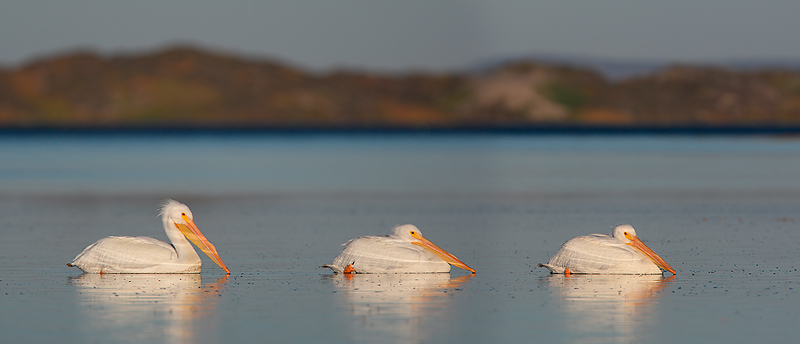
White Pelicans, Morro Bay, CA
Image copyright 2009
Arthur Morris/BIRDS AS ART
Handheld Canon 400mm f/4 DO IS lens with the 1.4X TC and the EOS-1D Mark III. ISO 400. Evaluative metering +2/3 stop: 1/2500 sec. at f/5.6.
This image is a composite of consecutive frames. The two birds in the front are actually the same bird (that fortunately changed its posture). The two images were combined using Quick Masking techniques.
EQUIPMENT REVIEW: THE CANON 800MM F/5.6L IS LENS
When I first heard that Canon was releasing an 800mm f/5.6 L IS lens my initial reaction was “That’s a stupid lens. Why use an 800 f/5.6 when you can use the 600 f/4 with a 1.4X TC?” As regular readers know I borrowed an 800 from Canon Professional Services for my Bosque trip, fell in love with it instantly, and ordered one through the Explorers of Light Program.
My very own 800 arrived minutes before I left for Los Osos and it made the trip with me. Now I love it even more. I have never been one who is impressed either by hype or by the technical specifications of a given product; I rely instead on how that product performs for me. I have created many great images in the short time that I have been working with the 800. You can find the manufacturer’s information here: http://tinyurl.com/25qtd8 and the technical specifications here: http://tinyurl.com/8olzqn.
Folks have been chomping at the bit for a complete review of this lens, but as I judge a lens by the results I will not have a lot to say other than that this is a great lens for many, many reasons. It offers great magnification. When compared with the 600mm f/4 L IS (with a full frame sensor camera) the 800 will render subjects more than 77% larger in the frame. And when used with either 1.3 or 1.6X camera bodies, these increases in magnification will be even greater. The 800 is slimmer and easier to handle and travel with than the 600, and not a whole lot heavier than the 500 (9.9 lbs vs 8.5 lbs). When it is not raining, I remove the lens hood making the lens that much lighter. The very best news is that I can easily support the weight of the 800 with only my left hand; this is a requirement for me when using my lightweight Mongoose M3.5. The 800 is the most accurate focusing lens I have ever worked with, most likely a result of the improved lens coatings. Every camera that I used on it focuses faster and more accurately on the 800 than on any other lens. Color rendition and edge to edge sharpness are superb and assuming no operator error the images are exceedingly sharp. The new 4-stop IS is simply amazing. (See the Osprey image below made at 1/6 second…)
The single biggest reason that I was so wrong in pre-judging this lens is that I failed to realize that I would be working without the 1.4X TC most of the time, and that I would rarely if ever be using the 2X TC. (At f/5.6 the new 800 will focus with the 1.4X and a pro body, but not with a pro-sumer body like the 50D.) George Lepp wrote yesterday, “I have made the comment in the past that you lose approximately 10% of the lens quality with a 1.4X, and approximately 20% with a 2X. If you have a good quality prime lens, you will still retain professional quality. These comments are based on my experience with the Canon 600mm f/4, the 300mm f/2.8, and the 500mm f/4 L IS lenses. I never recommend using extenders with zoom lenses except with the 70-200 (both the f/2.8 and the f/4 versions) and the 80-200mm lenses that were designed for use with extenders. I see photographers adding 1.4X and 2X converters to the 100-400mm all the time and I know the results are awful.”
Simply working at 800mm with the prime lens alone (rather than at 840 with the 600 and the 1.4X) will yield sharper images. AF acquisition will be faster and AI Servo AF more accurate.
I wish that the Minimum Focusing Distance were a bit less than 19.7 feet. At times, the 800 focal length may be too long. (Isn’t that a nice problem to have?) When I work at the one of the alligator farms, the 500 might be a better choice. At times, you will need to use the Human Zoom feature by taking many steps backwards. When working with photographers using the popular 500mm telephotos, you will need to stand well back from them. And all of the above goes double when you are using a 1.6X camera body like the 50D. With the 800/50D combo you are working at 1280mm, or more than 25X magnification. It will take practice just to find your subject in the viewfinder and you will need to employ your best Advanced Sharpness Techniques as described and illustrated in ABP II: 916 pages on CD only here: http://www.birdsasart.com/ABPII.htm. When working with the EOS-1D Mark III and the 1.4X TC the situation will be even tougher: 1456mm with more than 29X magnification.
At times, as you would expect, I miss having f/4 but the great high ISO performance of the EOS-1D MIII make that manageable. The light weight and great magnification more than make up for this minor inconvenience. Well, that is about all that I have to say; see the images in this and other Bulletins to see what I am talking about.
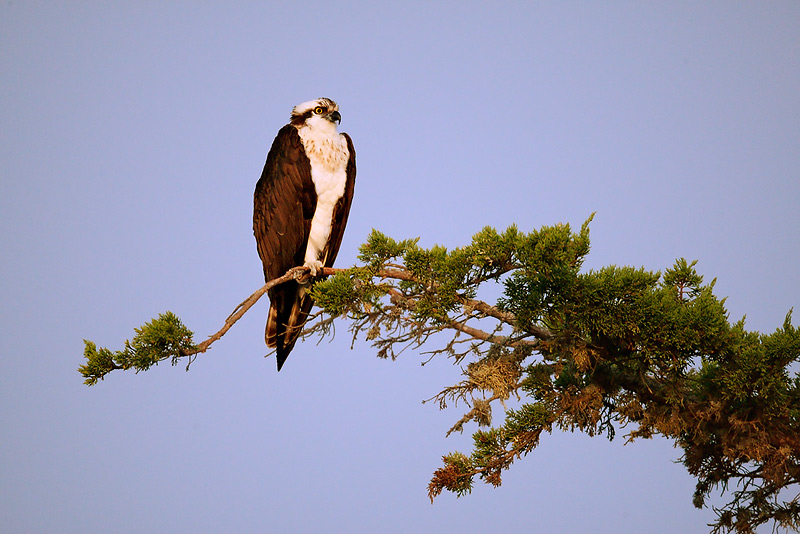
Osprey, pre-dawn, “Ain’t Digital Grand?” Morro Bay, CA
Image copyright 2009
Arthur Morris/BIRDS AS ART
Canon 800mm f/5.6L IS lens with the EOS-1D Mark III on the Gitzo 3530 LS CF tripod and the Mongoose M3.5. ISO 3200. Evaluative metering +1 1/3 stops: 1/3 sec. at f/5.6.
I was working in the dark at an insanely slow shutter speed hoping that the flash would render a sharp image. The problem was that I forgot to attach the flash cord. While editing (in Breezebrowser as always) I was stunned to see that I had created a sharp image at 1/3 sec. I have never created a sharp image with a long lens at anything slower than 1/30 sec. Explanation? I do remember locking down the Mongoose M3.5 after making a few images (all of which were unsharp). But the new 4-stop IS surely helped. Now don’t get me wrong, I am not saying that you or I can consistently produce sharp images at 1/3 sec. with this lens but with perfect technique it is possible on occasion. Note also the fine looking image quality at ISO 3200, the magic of the Mark III.
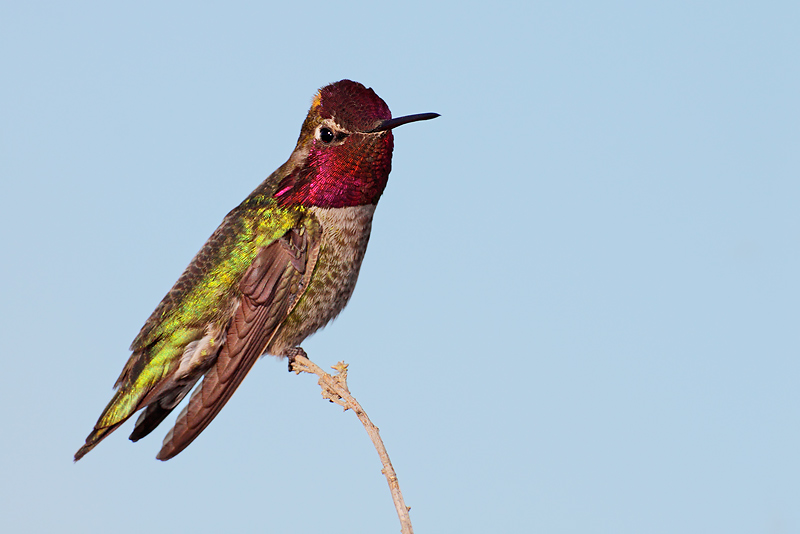
Anna’s Hummingbird, male, Morro Bay, CA
Image copyright 2009
Arthur Morris/BIRDS AS ART
Canon 800mm f/5.6L IS lens with a 25mm Extension tube and the EOS-50D on the Gitzo 3530 LS CF tripod and a Mongoose M3.5. ISO 320. Evaluative metering +1/3 stop: 1/800 sec. at f/8 in Manual mode. Fill flash with Better Beamer at 0.
This image is only a small crop. With the addition of a single 25mm Extension tube, the 800 will prove to be a great lens even for small birds.
NEOS KUDOS
I got this e-mail yesterday from Howard Burkert:
Greetings, With 12" of new snow, here in NW Ohio, I tested my new "NEOS" overshoes. They are awesome, lightweight, and easy on and off. I wore my comfortable everyday shoes and my feet and pants stayed dry. I hardly knew that I had boots on. Thanks for the information about them and for the fast shipping. Best, Howard
You can learn more about or order your pair of NEOS here: http://www.birdsasart.com/Neos%20Page.htm. My NEOS really came in handy while I was in the mud at Morro Bay! Everyone in the groups wished that they had a pair (except for Bill Keown who had ordered his from us!).
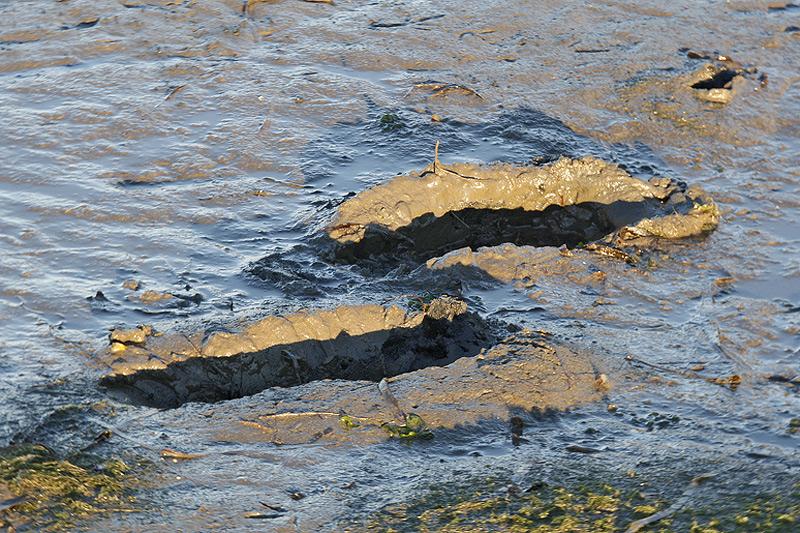
My footprints in gooey mud, Morro Bay, CA
Image copyright 2009
Arthur Morris/BIRDS AS ART
Would you want to walk in my shoes without your NEOS on? I think not.
IPT UPDATES
I will be teaching fewer and fewer IPTs each year. If you want to learn from the very best, do consider signing up ASAP.
POST-NANPA 2 ˝
DAY BOSQUE IPT.
Be
Be
Bear
Boat #1 is cheaper by $250 as we use the float plane only once: $6749. Bear
Boat #2: $6999.
Bosque 2009
IPT:
Australia Birds, DEC 2009. Please e-mail us at birdsasart@att.net or birdsasart@verizon.net for details, costs, cancellation policy, and itinerary.

Turkey Vulture scavenging Ring-billed Gull, Morro Bay, CA
Image copyright 2009
Arthur Morris/BIRDS AS ART
Canon 800mm f/5.6L IS lens with the EOS-1D Mark II on the Gitzo 3530 LS CF tripod and the Mongoose M3.5. ISO 400. Evaluative metering +1/3 stop: 1/400 sec. at f/5.6.
I spent almost an hour creating this image above from the original below. I leveled the image, did lots of work on the reds, cleaned up a ton of stuff on the beach, and removed the front end of another vulture. I used many different techniques to optimize the photograph. All of them are described in Digital Basics (http://www.birdsasart.com/digitalbasics.htm) and/or in and Robert O’Toole’s APTATS CD (http://www.birdsasart.com/aptats.htm. Do note that although the image optimized image more pleasing artistically that the natural history of the moment has not been changed: the vulture is still scavenging the gull.
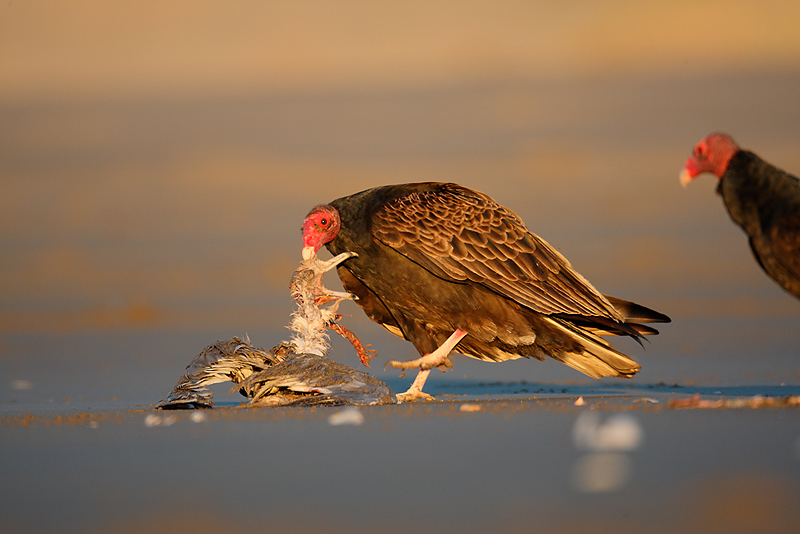
Best and
love and great picture-